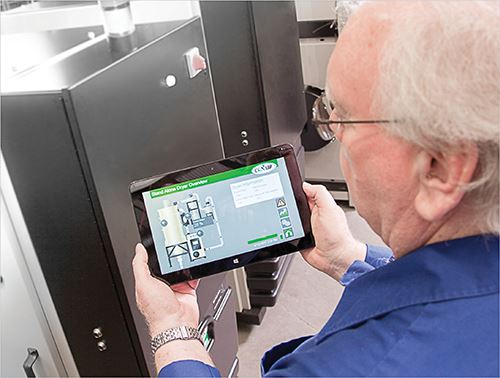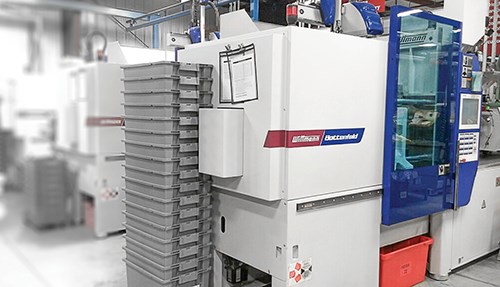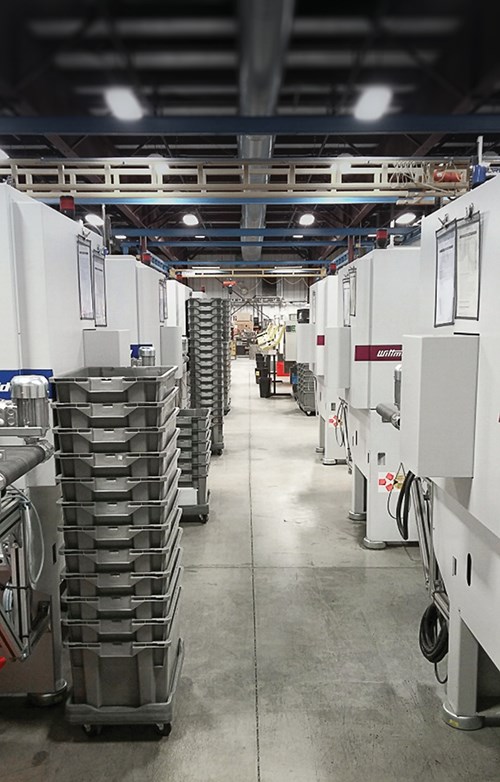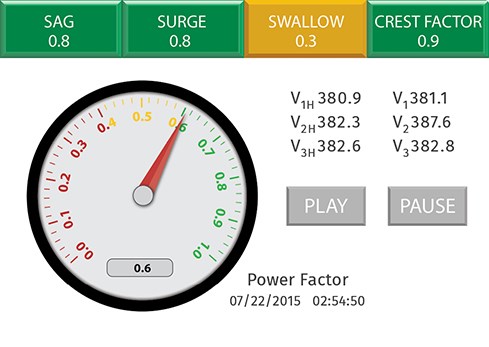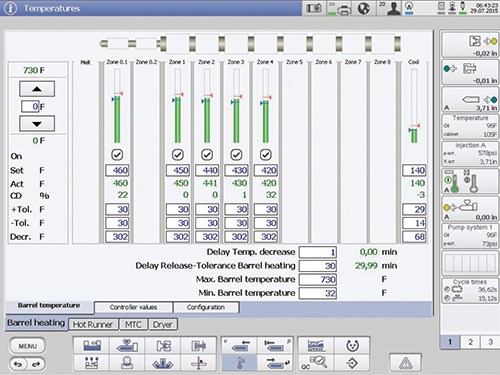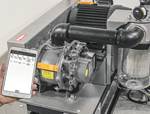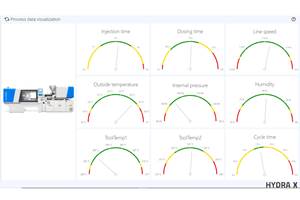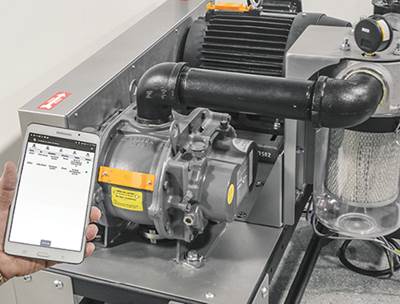'Talking’ Machines Pave the Way for Processing Plants of Tomorrow
At the convergence of smarter equipment, open communication protocols, and more powerful networks, a new shop floor emerges where groups of intelligent machines work seamlessly as integrated systems.
First, machines replaced manpower with steam power. In time, steam gave way to electricity; and then computer control displaced mechanical control. Now, machines are gaining intelligence, with self-awareness of their own condition and productivity and the ability to communicate their status to other machines and operators.
When Phil Dunn started in injection molding more than 20 years ago, the aging machines he worked with were decidedly analog. Featuring dials, relays, and switches instead of touchscreens, servomotors, and modems, operators consulted printed instructions to set up the equipment by hand. For example, pneumatically driven robots were manually coaxed into position so limit switches could be set. Machinery could be “read” via gauges but did not “talk” to operators, and certainly didn’t communicate with neighboring devices.
Today, as molding supervisor at automotive supplier ITW Seat Components in Lakeville, Conn., Dunn is awaiting delivery of his eighth fully integrated molding cell from press, robot, and auxiliaries supplier Wittmann Battenfeld, Torrington, Conn. Once installed, all the equipment in that cell—including the molding machine, robot, and temperature-control unit (TCU)—will share operations seamlessly, communicating with each other and the operator. The mold will digitally hand off the necessary settings for the press, TCU, and robot when it’s installed, allowing setup in 25 min. vs. up to 2 hr in the analog days.
“Everything comes up into one program, so there’s no need for anyone to adjust anything,” Dunn says. “You load that one program and your water heater is set, your hot-runner controller is set, your robot program pulls up, and that’s set. Back when I started in molding, they didn’t have closed-loop systems.”
Today’s advances represent the closing of all the loops in the system—within the machines, within the cell, and within the plant. Machines that communicate seamlessly with one another are one leg of a three-pronged concept that is reshaping manufacturing and forcing equipment suppliers to rethink the products they sell. Known variously as the Internet of Things (IoT), Industrial Internet, or Industry 4.0, the concept is becoming a reality for equipment suppliers who want stay at the leading edge of what many consider the fourth industrial revolution.
“Interconnectivity is really one of our guiding principles,” explains Paul Grekowicz, v.p. of marketing and product development at auxiliary-equipment supplier ACS Group, New Berlin, Wis. “It’s a fundamental design principle in all of our new-product development for anything that has any type of control associated with it.”
As enterprise software research director at ARC Advisory Group, Boston, Ralph Rio consults with a variety of industrial companies on the impact of IoT, spending a lot of time separating the hype from the reality; but beneath the buzz, Rio says sweeping change is coming: “Five years from now, if you’re an OEM making equipment, and you don’t have a remote monitoring service, I don’t know how you’ll be able to stay in business.”
TIP OF A MULTI-TRILLION-$$ ICEBERG
Forecasts of IoT’s potential economic impact range from $3.9 trillion to $11 trillion per year by 2025, according to a June 2015 report from McKinsey Global Institute (mckinsey.com). IoT in factories for operations management and predictive maintenance leads all categories, with a predicted value between $1.2 to $3.7 trillion, far outpacing IoT adoption in areas like home and health. Benefits of IoT include 10% to 20% energy savings and a 10% to 25% improvement in labor efficiency, according to the report.
Plastics Technology interviewed analysts, processors, and auxiliary equipment suppliers to figure out what IoT means for plastics now and what it could mean in the future, as the industry approaches a new frontier.
“We’re at the beginning,” explains Carl Litherland, head of group marketing at auxiliary supplier Motan Holding GmbH, Konstanz, Germany (U.S. office in Plainwell, Mich.). “Industry 4.0 is definitely not just a theory or thing we’re only talking about. We’re actually working at it, but I don’t think there are really very many production facilities that are completely integrated all the way through.”
With hype comes jargon, and that’s certainly the case for this concept. It’s known by three different names, which are often used interchangeably, although all have different origins and slight variations in meaning. IoT, which has the oldest etymology, dating back to 1999, originally related to an early effort in radio-frequency identification (RFID) involving MIT and Procter & Gamble.
In 2011, Industry—or rather Industrie—4.0 was first used in Germany at the Hanover Fair. Favored by Europeans, the “4” refers to a fourth industrial revolution, where digital technologies help to further automate manufacturing, with particular emphasis on the development of a common machine language.
The Industrial Internet, meanwhile, was coined by U.S. conglomerate General Electric in 2012, and concerns joining advances in machinery with those in computing.
In the 16 years since its first use, IoT has further come to reflect the marriage of smart machines with so-called Cloud Computing, using the Internet to harness the computing and storage power of remote servers and workstations to gather, organize, and interpret data fed to it by widely deployed sensors on a continuous, real-time basis. The sensors collect so much data that in many cases it would be impractical, if not prohibitively expensive, to store and process it locally, necessitating the mass computing resources of the Cloud.
For ARC’s Rio, it is the simultaneous alignment of advances and subsequent economies of scale in all these areas that have made the first steps towards IoT implementation possible. “You can think of it as a chain,” Rio says. “If there was a weak link in the chain, the whole space would not be very usable. Suppose cloud applications were really cheap, but it cost you $1 million to put the processor inside your machine. The Cloud application could have a price of zero, and you still wouldn’t do it.” Likewise, the proliferation of Wi-Fi networks further lowers a barrier to entry, eliminating the need for more expensive cellular connectivity, while the economies of scale behind Cloud applications—thanks to the ubiquity of smartphones, which increasingly rely on and connect to the Cloud—have resulted in a robust IoT infrastructure.
ACS Group’s Grekowicz adds that the boost in computing power and drop in cost of industrial PCs has also helped push IoT towards broader adoption. “The cost points are becoming more reasonable,” he notes. “We probably could have done something like this five years ago, but the costs would have been outrageous; it never would have flown.”
A DIFFERENT PATH
At NPE2015, auxiliary equipment supplier Novatec, Baltimore, unveiled its plans to bring IoT to plastics (see February Close Up). Throughout its development before the show, and in the months since its introduction, Novatec president Conrad Bessemer and Biplab Pal, chief technology officer at partner company Prophecy Sensorlytics, Columbia, Md., have weighed the potential cost impact of every single design and functionality choice they’ve made. This cost consciousness has steered the company down a different path, made possible only by IoT.
“This is the right time for our technology,” maintains Pal. “Most of the technologies we are using didn’t even exist two years back. Ten years back, could we have done this? No, not at these prices.”
With Novatec and Prophecy’s technology, small machine-mountable sensors are magnetically attached directly to a piece of equipment and begin transmitting data wirelessly to a local device or network, which then sends that information to the Cloud for intensive interpretation via proprietary algorithms. The sensors themselves borrow from the sensor-on-chip technology at the heart of the wearable electronics boom, another emerging sector with trillion-dollar values attached to it.
In the past, a much more expensive sensor would have been integrated directly into the equipment. Hardwired into the machine’s PLC, it would bring with it the added cost of installation and coding; and once in place, the data it collected would have to be stored and processed on a local server, requiring more computing power, expensive licensed software, and storage space. If the decision were made to add process-controller connectivity to the sensor network, it would then create a potential security weakness for the operation by wirelessly transmitting potentially sensitive production data.
By not working through the equipment’s PLC, Novatec’s Prophecy avoids cost and security hurdles. “In our case, we are staying a million miles away from process data and process controls,” Bessemer says of the sensors, which do not tie into the PLC and track metrics like throughput, but instead gauge things like vibration or magnetic field to judge machine health. “We never overtake a machine,” Bessemer says. “We’re not talking about pounds per hour, we’re not talking about recipes. The whole concept here is relatively low-cost, because if you start talking about thousands of dollars versus hundreds of dollars, that’s not going to be bought into, not in this industry.”
After a successful introduction at NPE2015, Bessemer and Pal noted that like any startup, Prophecy’s business plan is continuously changing. Feedback at the show, and subsequent testing in the lab, are pushing the concept into at least two other areas: retrofittable predictive-maintenance sensors for pumps and dryers already in the field (including non-Novatec equipment); and a new sensing product for gauging power quality and usage by machines.
At Novatec’s lab in July, Prophecy sensors on pumps and dryers continuously tracked data, noting failure modes for everything from low oil level to clogged filters. Not quite one year into their research, Pal and his team have already gone through various iterations of sensors and strategies. “We literally made advances every week,” says Steven Gillmeister, Novatec product development and test engineer. It’s apparent that those advances came at all hours, given the rollaway bed folded and stowed against the office wall. Work goes on around the clock, regardless of whether Gillmeister and his team sleep. However, thanks to what Pal calls an “army” of around 25 employees back in his native India, who take the data collected in the lab and feed it into newly developed algorithms throughout India’s day and Maryland’s night, the team has new developments to consider each morning. As the work progresses, insights into how and when pumps and heaters fail come more quickly, thanks to the ability to run sampled data through a gamut of virtual scenarios.
IoT TODAY
All the auxiliary equipment suppliers Plastics Technology spoke with for this article currently offer equipment with varying levels of connectivity, and all of them are working on even further developments along the IoT path.
The Conair Group, Cranberry Township, Pa., has offered web-enabled controls for its equipment since 2011, starting with material handling before expanding into dryers, drying monitors, and blenders, according to Bob Criswell, mechanical engineering manager. All Conair blenders have material-use reporting built in and can generate reports, which thanks to the web-enabled controls, can be read or exported remotely. SQL programming actively polls each connected blender and automatically pools the data into a single database.
Conair’s equipment can also communicate with other products, with some TrueBlend blenders, for example, allowing users to control attached loaders directly from the blender control panel; or the DC-T Touchview dryer control allowing control of multi-hopper systems when used as a central dryer.
The ACS Group, meantime, considers its current work towards a more connected product line to be part of a broader effort at reorienting controls towards a younger operator. “The biggest dynamic I’m seeing is the changing workforce for many of our customers,” says ACS’s Grekowicz. “The maintenance personnel, the operators—you’ve got a very significant portion of that workforce that is at, or even beyond, the retirement age, so there’s a definite need to change controls technology to something that’s going to be more important to the next generation of the work force coming in.”
Grekowicz noted that ACS was working on fuller communication between central chillers and individual temperature-control units (TCUs). In general, Grekowicz said, ACS will look to better leverage the connectivity already present in many of its products like blenders, which can be connected to wireless devices. “For a blender or a dryer or a conveying unit and any of the associated hardware, they should all talk to each other,” Grekowicz said. “They’re all moving, drying, or blending plastics; that’s a system and that should talk to itself.”
Beyond the machine, Wittmann Battenfeld’s Quicklook app allows users to set up a monitoring link on a handheld device to track a variety of production parameters in a cell, within a given network, tying directly into a static I.P. address for a piece of equipment, according to Sonny Morneault, v.p. of sales.
The company’s TCUs, robots, dryers, and injection molding machines are all completely integrated in a way that’s unique in the plastics industry, according to Wittmann Battenfeld, since it is the manufacturer of all those products and their controls. A standard Euromap interface on a press, for example, only takes “basic signals” from a TCU, while full communication occurs amongst Wittmann Battenfeld products. In the future, the company is planning to fully integrate its blenders and digital water-flow regulators.
Italian auxiliary equipment supplier Piovan SpA offers its customers connectivity via its WinFactory software. Allowing remote monitoring and control, WinFactory comes as a standard package with what Piovan calls operative and management modules. Operative modules allow operators to interface with equipment from a remote station and control the status of every machine.
Piovan’s equipment is offered here through its subsidiary, Universal Dynamics Inc., Woodbridge, Va. UnaDyn also offers its own F.A.C.S. (Factory Acquisition Control Systems) package for control and monitoring. A distributed control that eliminates the need for conduits and wiring, F.A.C.S. is a Windows-based platform to control and monitor the entire material-handling system, including drying, blending, and silo inventories, with the ability to communicate with SPI-compatible equipment. WiFACS is the remote version, allowing users to view and control system operations remotely through compatible handheld devices.
Moretto SpA, an Italian company with a new U.S. operation in Columbus, Ohio, offers its in-house developed MOWIS modular control platform. MOWIS supports feeding, drying, dosing, storage, and cooling modules, which can be integrated with one another. In addition to traceability, it allows real-time control of system conditions, with a multi-user platform for control from different locations. Remote connectivity is possible via Ethernet or Wi-Fi, and the system can link to ERP programs.
‘TALKING’ MACHINES NEED ONE LANGUAGE
Motan will give processors a glimpse of its approach to IoT at the Fakuma show next month in Germany. There, teaming up with machine supplier KraussMaffei, Motan will showcase a “demonstration project,” says Peter Breuer, Motan’s head of group training and innovation management.
The efforts of European companies like Motan and KraussMaffei reflect a schism of sorts in the understanding and implementation of IoT across the Atlantic. “From our point of view, the main difference between the attempts in Europe and the U.S. is the focus on the definition and standardization of common interfaces in Europe by VDMA (German Machinery Association) and Euromap,” explains Breuer, “versus the ad hoc use of internet technology—the Cloud—in the U.S.”
For European suppliers, the biggest development of recent years has been the creation of the OPC Unified Architecture (OPC UA). This communication protocol is described by its creator, the OPC Foundation, as “platform-independent”—compatible with PCs, PLCs, micro-controllers and Cloud-based servers, as well as a variety of operating systems, including Windows, OSX, Android, and Linux.
“The new OPC UA is an interface that’s been designed from the outset to be completely standard,” Motan’s Litherland explains. “In other words, it’s open to everybody to use and, in our opinion and in the opinion of a lot of other manufacturers, I it’s going to become the standard interface which we will all be using in the future to communicate with each other.”
Lack of a common language has long been a hurdle for a more communicative factory floor. “This is the beauty of OPC UA,” Litherland explains. “It’s an interface for everyone, and that’s the whole point of Industry 4.0. It’s not the ability to communicate among my own equipment made by my own company, it’s being able to share and communicate information with the whole production environment of our end customer.”
While the vision of having all the production equipment along an entire supply chain in constant communication is fascinating and technically feasible, it remains a long way off. “In plastics, I’d say we’ve got a ways to go but we’re already doing a lot of Industry 4.0,” Litherland says. “What I find really exciting is where you have the whole production facility talking, but not too many customers are there because the suppliers haven’t gotten the interfaces up and running yet, or they aren’t willing to open up their interfaces to be able to talk with other pieces of equipment. It’s a little bit like, ‘Show me yours and I’ll show you mine.’’’
Related Content
What to Look for in High-Speed Automation for Pipette Production
Automation is a must-have for molders of pipettes. Make sure your supplier provides assurances of throughput and output, manpower utilization, floor space consumption and payback period.
Read MoreManufacturers’ Superpower: ‘X-Ray Vision’ into Your Processes
Meet a ‘new’ name (to North American processors) in MES software, which provides a simple, modular way to achieve visibility into your production operations.
Read MoreOpen Automation Enables Flexibility in Chemical Recycling
Software-defined equipment control systems can be duplicated, transferred and scaled with ease.
Read MoreEngel Teases Generative AI Assistant at Digital Days Event
The Austrian maker of injection molding machines and automation introduced a prototype large-language model assistant for its customers: Engel GPT.
Read MoreRead Next
Detect When Equipment Needs Maintenance—Before It’s Too Late
New technology to debut next month at NPE warns when preventive maintenance is needed, before equipment failure disrupts production.
Read MoreMaking the Circular Economy a Reality
Driven by brand owner demands and new worldwide legislation, the entire supply chain is working toward the shift to circularity, with some evidence the circular economy has already begun.
Read More

